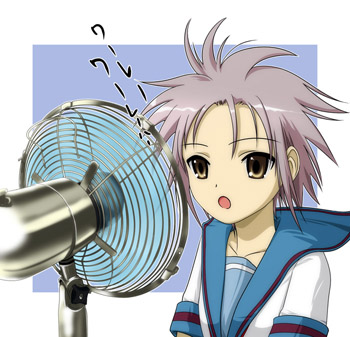So we finally reach the start of lesson one. Defining the terms took longer than I expected… Please make sure that you have read through the basic term definitions in Chapter 0 before continuing.

I assume that people who read this blog are, more often than not, fansub watchers. So for the first lesson today, instead of talking about “watashi wa John desu”, I’ll begin with something slightly more advance.
Part I: Verb Groups
Anyway, verbs. There are three main categories of verbs in Japanese and they are usually referred to as “Group 1”, “Group 2” and “Group 3”. Creative names huh. Usually when you start to learn Japanese as a foreigner, all the verbs you encounter end with “-masu”, such as ikimasu and tabemasu The truth is, the “-masu” suffix is a tense and you will never find the word “ikimasu” in a dictionary. The words are actually iku and taberu.
I will be presenting all the examples using the dictionary form and I will explain how and why they are converted to the “-masu” form.
Examples
Group 1
打㤠utsu
èªã‚€ yomu
èžã kiku
çªã£è¾¼ã‚€ tsukkomu
戸惑ㆠtomadou
犯㙠okasu
æ»ã¬ shinu
当ãŸã‚‹ ataru
帰る kaeru
入る hairu
切る kiru
ã‚ã‚‹ aru
è¡Œã iku
Group 2
消ãˆã‚‹ kieru
ç€ã‚‹ kiru
å¥ã§ã‚‹ kanaderu
逃ã’ã‚‹ nigeru
変ãˆã‚‹ kaeru
ã„ã‚‹ iru
食ã¹ã‚‹ taberu
å¯ã‚‹ neru
借りる kariru
èŒãˆã‚‹ moeru
焼ã‘ã‚‹ yakeru
分ã‘ã‚‹ wakeru
生ãã‚‹ ikiru
生ã¾ã‚Œã‚‹ umareru
Group 3
ã™ã‚‹ suru
ãã‚‹ kuru
å˜åœ¨ã™ã‚‹ sonzai suru
性交ã™ã‚‹ seikou suru
浮気ã™ã‚‹ uwaki suru
変更ã™ã‚‹ henkou suru
I think if I leave you to stare at the examples long enough, you will see some pattern as to how the groups are determined. There are some exceptions of course, but generally the pattern is easy to understand. And for those of you who read Japanese, yes some of the examples are meant to be weird. ;)
Group 3
First things first, let’s get the easiest group out of the way.
There are only two Group 3 verbs: ãã‚‹ kuru (“to come”) and ã™ã‚‹ suru (“to do”). The rest are just various combinations of noun + suru (literally “to do [noun]”).
Simple huh.
As for differentiating Group 1 and Group 2 verbs, the first rule of thumb is by the last hiragana character.
Group 1
Group 1 verbs end with one of the following hiragana:
ã†ã€€ã ã ã™ã€€ã¤ã€€ã¬ã€€ã‚‹ã€€ã‚€ ã¶
u ku gu su tsu nu ru mu bu
Group 2
Group 2 verbs always end with ã‚‹ ru.
The second last hiragana in a Group 2 verb will always have either a trailing “e” (read “ei” like “A” in “ABC”) or “i” (read “yi”, like “E” in “EFG”) sound. For example, 分ã‘ã‚‹ wakeru.
General Guidelines
A verb that ends with anything but -ru is ALWAYS Group 1, but the reverse is not true. 当ãŸã‚‹ ataru ends with a -ru, but it is Group 1 and not 2 because the second last hiragana does not have a trailing “e” or “i” sound. 帰る kaeru, 入る hairu and 切る kiru on the other hand all fulfill the Group 2 requirements, but yet they are in Group 1. As with all language rules, there are exceptions and there is no way around it but pure memorization.

Note that all the rules only apply for the dictionary form of verbs. The trailing hiragana changes depending on the tense, in which case it will not match the ones above. But if you are certain that a word is in its dictionary form and yet the last hiragana does not fit any of those listed above, then it is most likely not a verb.
If you observe the kanji and the trailing hiragana for each group, you can probably notice a better way to differentiate the two groups, but I am not going to cover it because it is somewhat more confusing (for those who want to try, the only exception for that rule is å¯ã‚‹ neru being in Group 2).
Review
Let’s say you encounter the verb æ³³ã oyogu (“to swim”)
First you check the trailing hiragana: ã gu
Result: Group 1. Only Group 1 verbs can end with -gu.
Another example: å±ã‚‹ shikaru (“to scold”).
First you check the trailing hiragana: ã‚‹ ru
Result: Inconclusive, -ru can be found in both groups.
Then you check the second last hiragana: ã‹ ka (å±ã‚‹ when written out in full hiragana is ã—ã‹ã‚‹)
Result: ka does not end with a trailing “e” or “i” sound, therefore å±ã‚‹ shikaru is Group 1.
It’s pretty simple, you just have to remember the exceptions that end with -iru or -eru and yet are in Group 1. Some common exceptions are 帰る kaeru (“to return home”), 入る hairu (“to enter”) and 切る kiru (“to cut”).
Exercise
Using the rules I’ve given above, try to group the following in Group 1 or 2.
- 騒ã sawagu
Group 1. - 入れる ireru
Group 2. - 変ã‚ã‚‹ kawaru
Group 1. - å ㆠuranau
Group 1. - 回る mawaru
Group 1. - é¿ã‘ã‚‹ sakeru
Group 2. - 痛む itamu
Group 1. - 焼ã yaku
Group 1. - 生ã‹ã™ ikasu
Group 1. - æ¬ ã‘ã‚‹ kakeru
Group 2. - é™ã‚Šã‚‹ oriru
Group 2. - 打ã¡åˆã‚ã›ã‚‹ uchiawaseru
Group 2. - 試㙠tamesu
Group 1. - 猫ã¿ã¿ nekomimi
Not a verb. Neko Mimi Mode desu~~~ - ã¶ã£æŽ›ã‘ã‚‹ bukkakeru
Group 2. It’s really a verb.

Part II: “-masu” Form
I will spend the second half of this introduction to Japaese verbs by teaching the -masu form. Most language schools teaching Japanese as a foreign language will actually start with the -masu form first before teaching the dictionary form.
This is due to two main reasons. The first is because the -masu form is much more polite than the dictionary form. In fact, -masu is also known as the polite form. So by teaching a foreign student who has just started learning Japanese the polite form first, he or she would not go around offending people unknowingly. Tense manipulation in the polite form is also simpler.
Conversion
Here’s how you convert dictionary form to polite form.
Group 1
Example: å’²ã saku (“to blossom”)
Assuming you know your hiragana table, take the trailing hiragana from the verb, which is ã ku in this case, and match it with the hiragana that is in the same row but has a trailing “i” sound. What we want is ki.
The “k-” row: ã‹ã€€ka ã ki ã ku ã‘ ke ã“ ko
Replacing ku with ki and add masu to the end, and viola! We get å’²ãã¾ã™ sakimasu. This works for all Group 1 verbs.
Other examples:
打㤠utsu = 打ã¡ã¾ã™ uchimasu
èªã‚€ yomu = èªã¿ã¾ã™ yomimasu
èžã kiku = èžãã¾ã™ kikimasu
çªã£è¾¼ã‚€ tsukkomu = çªã£è¾¼ã¿ã¾ã™ tsukkomimasu
戸惑ㆠtomadou = 戸惑ã„ã¾ã™ tomadoimasu
犯㙠okasu = 犯ã—ã¾ã™ okashimasu
æ»ã¬ shinu = æ»ã«ã¾ã™ shinimasu
当ãŸã‚‹ ataru = 当ãŸã‚Šã¾ã™ atarimasu
帰る kaeru = 帰りã¾ã™ kaerimasu
Group 2
Too simple. Just take off the trailing ã‚‹ ru and replace with masu
Examples:
消ãˆã‚‹ kieru = 消ãˆã¾ã™ kiemasu
ç€ã‚‹ kiru = ç€ã¾ã™ kimasu
å¥ã§ã‚‹ kanaderu = å¥ã§ã¾ã™ kanademasu
逃ã’ã‚‹ nigeru = 逃ã’ã¾ã™ nigemasu
変ãˆã‚‹ kaeru = 変ãˆã¾ã™ kaemasu
ã„ã‚‹ iru = ã„ã¾ã™ imasu
食ã¹ã‚‹ taberu = 食ã¹ã¾ã™ tabemasu
Group 3
There are only two of them, so just memorize.
ã™ã‚‹ suru = ã—ã¾ã™ shimasu
ãã‚‹ kuru = ãã¾ã™ kimasu
å˜åœ¨ã™ã‚‹ sonzai suru = å˜åœ¨ã—ã¾ã™ sonzai shimasu
性交ã™ã‚‹ seikou suru = 性交ã—ã¾ã™ seikou shimasu
Polite Past Tense
“I went.”
This is pretty easy too. Just change the suffix from masu to mashita, no matter which group it is. This applies to polite form only. I will be covering tenses for dictionary form at a later date.
èªã¿ã¾ã™ yomimasu = èªã¿ã¾ã—㟠yomimashita
消ãˆã¾ã™ kiemasu = 消ãˆã¾ã—㟠kiemashita
ã—ã¾ã™ shimasu = ã—ã¾ã—㟠shimashita
Polite Negative
“I [will not / do not] go.”
Japanese does not differentiate between “will not” and “do not” and uses negative in both cases. Again, what I have here is for the polite form only. The normal negative form will be covered at a later date. Simply replace all masu with masen
èªã¿ã¾ã™ yomimasu = èªã¿ã¾ã›ã‚“ yomimasen
消ãˆã¾ã™ kiemasu = 消ãˆã¾ã›ã‚“ kiemasen
ã—ã¾ã™ shimasu = ã—ã¾ã›ã‚“ shimasen
Polite Negative Past
“I did not go.”
This is simply a matter of adding deshita to the end of the polite negative form.
èªã¿ã¾ã™ yomimasu = èªã¿ã¾ã›ã‚“ã§ã—㟠yomimasen deshita
消ãˆã¾ã™ kiemasu = 消ãˆã¾ã›ã‚“ã§ã—㟠kiemasen deshita
ã—ã¾ã™ shimasu = ã—ã¾ã›ã‚“ã§ã—㟠shimasen deshita
Review
Converting to and from polite form is pretty easy so I won’t make an exercise for it. Or I’m just too lazy to. :3 You just have to remember the two Group 3 verbs and the general rule for the Group 1 verbs. Even a chimpanzee can convert Group 2 verbs to polite form.
Similarly, converting from polite present to polite past, polite negative or polite negative past is a simple matter of following the general rule. There are no exceptions for these three rules. Hurray.

Conclusion
In the first chapter, we talked about:
- Verb groups
- Dictonary form
- Polite / “-masu” form
- Polite past, negative and past negative
Have fun~ Check back some time again for the second chapter if I ever get to writing it. Turns out I did finally write it… Click on the link below.
P.S. I do realize that the pictures have nothing to do with the topic… ;)

“P.S. I do realize that the pictures have nothing to do with the topic…”
eh, I like the pictures being there though. =P
love the article too it’s quite helpful for us who doesn’t know moon-speak.
looking forward for more of these. ;)
You forgot to explain to your readers what “seikou suru” and “uwaki suru” mean ;)
Wha? There was a Japanese lesson in there? I was too busy looking at Nagato…
I am surprised you have the patience to type this stuff out. Then again, I’m copying what appears to be a 50-page paper on Japanese cultural power in richtext.
>> it’s quite helpful for us who doesn’t know moon-speak.
ã§ã‚‚ã€ãƒ ーンスピクã¯ã‚‚ã£ã¨ãŠã‚‚ã—ã‚ã‹ã£ãŸã€‚。。
jk :P
Nekomimi is too a verb. If English thinks status is a verb then I bestow verbage status on nekomimi. Let’s nekomimi that girl right now!
Pingback: shtuff: anime blogage » Infinite Energy Sources! (Akira Review)
Splendid! I’m always happy to see people trying to learn a language and Japanese hapens to be one of my favorites! Even though it’s a linguistically boring language (unless you’re an über-historian, you weirdo), I just love the sound of it. It has a very articulate and fluid quality. You may wish to note, however, that making a direct parallel between English and Japanese lexical classes can cause trouble later.
I’m excited that I found this site. ^.^ I’ve always wanted to learn Japanese, and I know that it may be easier if I took classes anyway (from someone I can talk Japanese back to), but this is great to read and begin to understand the basics. How much detail are you going to get into?
Love to pictures too! Keep up the lessons!
Have to agree with the majority of “we-love-moonspeak”monkeys (no hard feelings guys)^^………love the lessons!
However, they tend to loose some of it’s value when my computer refuses to “show” any alphabet that isn’t the one i’m currently typing. I seriously need a cure for this obvious disease. So if anyone knows where to find a “japlangpack” or something of the like I would be forever grateful.
Looking forward to be able to read the lessons ahead.
If you are using Windows XP, go to Regional and Language Options in Control Panel. Go to languages and check “Install files for East Asian languages”. You probably need the Windows XP CD for this.
If you already have it installed, then it might be the browser’s encoding settings. Go to View > Character Encoding (or Encoding in IE) and make sure Unicode UTF-8 is selected.
Darkmirage is our friend and savior!
Mark my words…..without him the world would know nothing but suffering and unspeakable anguish.
In short that means :
Thx for the help mate, it worked=)
Yaay! The first chapter! Should I have started here?
Wow! this is totally awesome, by just reading the first chapter i somehow gain a full confidence on Japanese now! I really wanted to learn some more of it now, and this is really like taking a Japanese lesson for real! LOL this’s really helped me now!
You forgot the Group I 㶠verbs like 飛㶠(ã¨ã¶) and 択㶠(ã†ã‚‰ã¶). Just because they’re rare doesn’t mean you can leave them out, I mean you have ã and 㬠in there afterall.
Yeah I guess I did leave out 㶠for some reason…
Amazing ! I just found this site and started the first lesson . I always want to study Japanese but it’s too difficult , I didn’t know where to start . It’s easier to take a class but in the contry I’m living they don’t teach Japanese . You’re great .
Thank you for the lesson . ^^
Thanks. ^^
This is the best japanese course I found so far.
I want to study japanese starting next year and even though I don’t have much time atm I try to prepare myself as much as I can for it.
*pads Yuki* You are also doing a good job. ^^
can you write the meaning in english for the examples? i wanna know what each word exactly mean lol
“Even though it’s a linguistically boring language”. What do you mean by that, Trent Arms?
Hey, this classes were a pretty good idea ^^ I’m enjoying them a lot…
Just something I noticed (nothing to do with japanese): it’s voilà , not viola.
Nice lessons ^^. I will be putting them, translated to Spanish, in a little forum with many links to you site if you don’t mind. I’m trying to gather a few basic lessons to start with Japanese, and yours are very helpful and understandable ^^. I’d put the link only, but some of them wouldn’t understand a word xD (I think they should learn english before japanese -.-)
Don;t mind if i request permission to Link your Japanese guides to my forum, Credit will be given for your hard work :D
Sure go ahead.
These verbs really get to me, hard to completely memorize-__-;;;
Pingback: Beginner's Japanese – Chapter I – Verbs - Ramblings of DarkMirage ã—ã‹ã€”~ã—ã‹ã€•?ã“ã‚Œã—ã‹ãªã„
Looking back at these verbs after I know what most mean… You chose some interesting ones DM
Thank you for this helpful lesson on Japanese Verbs! I’ve been wanting to learn Japanese for a while, and you’ve fueled my efforts!
I will work hard at this. :)
Thanks again,
Peace,
Legend